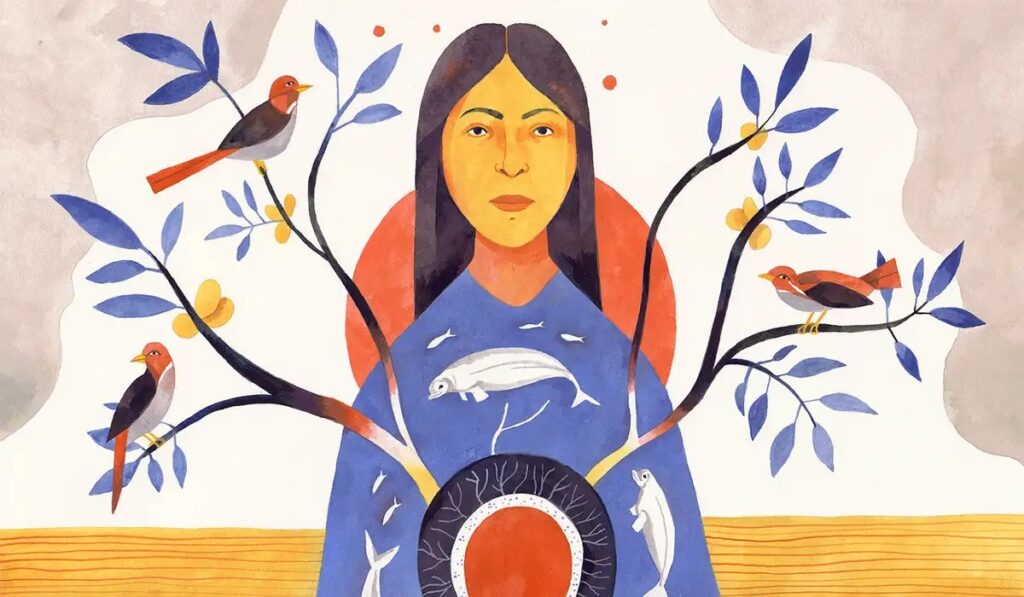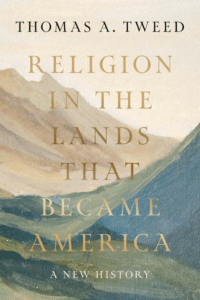Environmental Damage, Cultural Stress, and Religion in America
A review of “Religion in the Lands That Became America”

(Image source: Luisa Rivera/Yale E360)
In the twelfth century, Indigenous maize-growing communities in North America rivaled the size of contemporary European cities. The Ancestral Puebloans constructed great houses up to four stories high with as many as 650 rooms in Chaco Canyon, in what is now New Mexico. These astronomically aligned structures served as centers of religious ritual and political influence and represented the immense regional power of a few individuals. Farther east, in the Central Mississippi Valley, the city of Greater Cahokia had grown to nearly fifty thousand inhabitants and included the largest earthen mound in North America (now known as Monk’s Mound). Such mounds acted as ritual spaces for ceremonies and burials. Yet for all their wealth and power, both Chaco Canyon and Cahokia were soon to be abandoned. In Chaco, soil depletion and drought began to erode the authority of the priestly elite, whose primary role was ensuring the health of corn crops. Cahokia’s decline followed a similar pattern: floodwaters and the Little Ice Age put stress on a society already experiencing social and religious conflict, and the site was abandoned around 1300.
 These stories of collapse in pre-Colombian America are rarely told in surveys of American history, and their presence in Thomas A. Tweed’s Religion in the Lands That Became America highlight what is unique in Tweed’s approach. Tweed is a professor of history and American studies at Notre Dame known for his works on religion, and this new book seeks to tell the story of American religious history in more expansive and inclusive terms.
These stories of collapse in pre-Colombian America are rarely told in surveys of American history, and their presence in Thomas A. Tweed’s Religion in the Lands That Became America highlight what is unique in Tweed’s approach. Tweed is a professor of history and American studies at Notre Dame known for his works on religion, and this new book seeks to tell the story of American religious history in more expansive and inclusive terms.
As Tweed points out, many historical overviews begin with the arrival of White Protestants along the Atlantic coast and deal with other faiths primarily as they interact with those groups. Such books rarely address religion’s role in ecological and social change or the people displaced by environmental and cultural upheaval. These omissions and prejudices matter, Tweed argues, for the stories we tell “dictate whom we’ll remember and forget.” How we tell history changes how we perceive the present. In the case of America, it influences whom we are willing to include in the category of “American” and thus who has a right to determine America’s identity and course.
In a time of ecological stress and polarized narratives, many of which seek to reaffirm the restrictive histories Tweed criticizes, a wider understanding of American religious history—and its relation to social and environmental sustainability—is more important than ever.
To address such problems, Religion in the Lands That Became America is both temporally and spatially more expansive than other surveys. The book begins with the earliest evidence of religion in North America, dating to some 11,000 years ago, and includes discussions of U.S. territories, such as Hawaii and the Virgin Islands. Yet Tweed seeks to go even further, to show how religion is embedded within social and environmental shifts. He argues that all societies exist within an “eco-cultural niche”—the surrounding environment and an inheritance of “shared symbols, communal ceremonies, special objects, and sacred landscapes.” A niche can be either sustainable or unsustainable. To achieve the former, individual, communal, and environmental wellbeing must be widely available. Sustainability deteriorates when “multiple stressors converge—as when resources diminish, climate changes, disease devastates, injustice pervades, violence mounts, and religious worldviews no longer provide personal meaning and collective belonging.” Tweed’s emphasis on how such factors converge and influence one another allows him to explore the impact of religion “on the ground” while also raising questions about religion’s relation to contemporary issues. He asks, “Can contemporary faith communities use religion’s figurative tools to restore broken niches and remake sustainable worlds?”
The book is divided into four sections, each of which deals with a different social structure: foraging, farming, factories, and fiber optics. For each of these sections, Tweed examines numerous religious trends and how they relate to the sustainability of their historical moments, and he highlights four “sustainability crises.” The first of these involved the collapse of Chaco Canyon and Cahokia, which was resolved when those populations dispersed to more agriculturally sustainable areas and took up less hierarchical lifestyles. The last three of these crises, on the other hand, involve increasing eco-cultural stressors in U.S. society that have yet to be fully addressed.
The factors endangering modern sustainability coincide with the arrival of Europeans, who quickly established a presence marked by social inequality and environmental damage that was often interwoven with religious ideas. In New England many colonists believed they had been commanded by the Bible to subdue the earth, claiming the land by “planting crops, not flags.” Religion was also used to prop up slavery, and a “planter piety” developed—particularly in the South—which employed selective Bible readings and theology to justify chattel slavery and ecological exploitation. These factors contributed to what Tweed calls the “colonial crisis,” marked by the exploitation and traumatization of Indigenous and Black communities and the over-farming of Southern regions. Many of these problems are still with us.
The Industrial Revolution heralded the third crisis, in which the exploitation of labor and immigrants and the expanded degradation of landscapes put further stress on U.S. society. These issues became especially widespread after 1873, which saw the implementation of new industrial techniques heralding a turn to a wide-scale industrial economy. As with the colonial crisis, religion was deeply involved in these new social structures. Tweed shows how both religious conservatives and liberals responded to new technologies enthusiastically, with business leaders eager to justify their new wealth in spiritual terms. The evangelical Lyman Stewart, for instance, agreed with the relatively liberal John D. Rockefeller that fossil fuels “came from God.” Others embraced more idiosyncratic ideas, such Henry Ford’s belief that karma caused individuals to be reincarnated at lower social levels.
The fourth crisis began in the mid-twentieth century with the “Great Acceleration,” in which human action became the main cause of earth-system disruptions. Meanwhile, religious conservatives, such as Billy Graham, continued to support consumption and capitalist enterprise. Yet religion also proved an ally in the fight for ecological justice, whether from established institutional religion, as with the environmentally-oriented theologies of the Lutheran Joseph Sittler and the Catholic Teilhard de Chardin, or from the countercultural movements of the 1960s. Many religious social justice activists also made progress, such as Pauli Murray, a Black Episcopalian who formulated influential legal strategies that were employed in numerous civil rights and women’s rights cases.
Though much progress was made during the sixties and seventies in addressing the snowballing crises, much of it had fizzled out by the 1980s, and Tweed describes a society increasingly fragmented and incapable of alleviating injustice and environmental stress. The U.S. religious landscape continued to change as the country shifted to a post-industrial society. Many conservatives moved to their own media platforms, creating a polarizing rift in much national discourse. Some used these platforms to combat environmentalism, and backlash grew against progressive movements even as prosperity-gospel televangelists proliferated.
Despite such setbacks, Tweed ends his book on an optimistic note, with Occupy Wall Street and Pope Francis condemning the new “idolatry of money” and the increasing involvement of religious groups in climate activism. Tweed also sees cause for hope in Biden’s success in the 2020 election, stating that “by 2020, those arguing America is—or should be—an Anglo-Saxon Protestant nation found the claim even harder to make.” Unfortunately, Tweed stops his history there, with no mention of more recent political events that might cast a shadow over his optimism.
Religion in the Lands That Became America is both a criticism of and a corrective for simplistic narratives about American identity. As Americans face brutal immigration policies, religiously charged international conflicts, and conservative backlash against diversity and inclusion, Tweed shows both the falseness and danger of such thinking. Contrary to contemporary nationalism, Tweed demonstrates that America has always been a widely diverse place in which the real dangers have been social and ecological exploitation and the narratives that seek to justify it.
Yet the book’s great diversity also means that, like most surveys, it suffers from having more breadth than depth. One can easily get lost in a flood of detail that is never fleshed out, and the sheer amount of information can make it difficult to keep track of the story’s primary currents or to remember the specifics of any particular event. This can hardly be avoided in a book of this kind, however, and Tweed shows himself an adept writer and storyteller as he threads together a truly astonishing amount of historical detail. The pre-Colombian and Indigenous history is particularly welcome, and Tweed’s decentralization of White Protestantism tells a truer and more interesting story about religion in America.
It becomes clear in reading the book that post-Columbus America has a great deal of work to do if it is to address the many crises it currently faces. Ongoing ecological instability, social injustice, and the current rise of a nationalistic Religious Right show that we have a long way to go before we can speak of a truly sustainable eco-cultural niche in America. Religion, moreover, plays an important role in that process, especially in determining a society’s response to potential stressors.
Tweed reveals how religion can influence an eco-cultural niche both for good and for ill. Religious leaders all too frequently use their power and theology to justify exploitation and inequality, but alternatives are always possible, and many of the most dynamic and effective voices for progress have been religious. The difference between the two is often a difference of the stories one embraces. Those narratives most conducive to sustainability and progress are those willing to acknowledge damage and hear the voices of others, especially of the poor and exploited. The more destructive narratives are those that seek primarily to justify power and accumulation at the expense of others.
We are still in the midst of such competing stories. As Tweed outlines, in an increasingly fragmented media landscape, politics are more polarized than ever, and much of the book looks like a conflict between two primary religious worldviews. On the one hand is religious conservatism and nationalism, which combine elements of American civil religion with reactionary Christianity, and occasionally other traditions. On the other hand are progressive religious movements and their allies seeking to address the crises harming numerous communities and the global environment. Such a summation oversimplifies Tweed’s work, but as American politics grow ever more polarized and destructive in Trump’s second term, that binary looks more apt, and the failures to find common ground and address our inherited crises more dangerous. That only the first crisis Tweed discusses—that of Indigenous maize communities—has been resolved, largely by social collapse, ought to serve as a warning.
Tweed positions his book to influence American culture; it serves as a plea to come to grips, after nearly five hundred years, with the burdens of our history and ecological irresponsibility. To do this, we must undo simplistic narratives of God-given consumption and abundance in order to recognize our failures and our real successes. For now, the optimistic tone at the book’s end appears unwarranted, and only time will tell if America will heal or fragment further. Whatever happens, Tweed has made an impassioned case for healing and done much to reveal America’s beautifully colorful and horrendously exploitative past.
Ben Woollard is a writer based out of northern California. His work has appeared in JSTOR Daily, Comment, Lit Hub, The Asian Review of Books, and elsewhere.